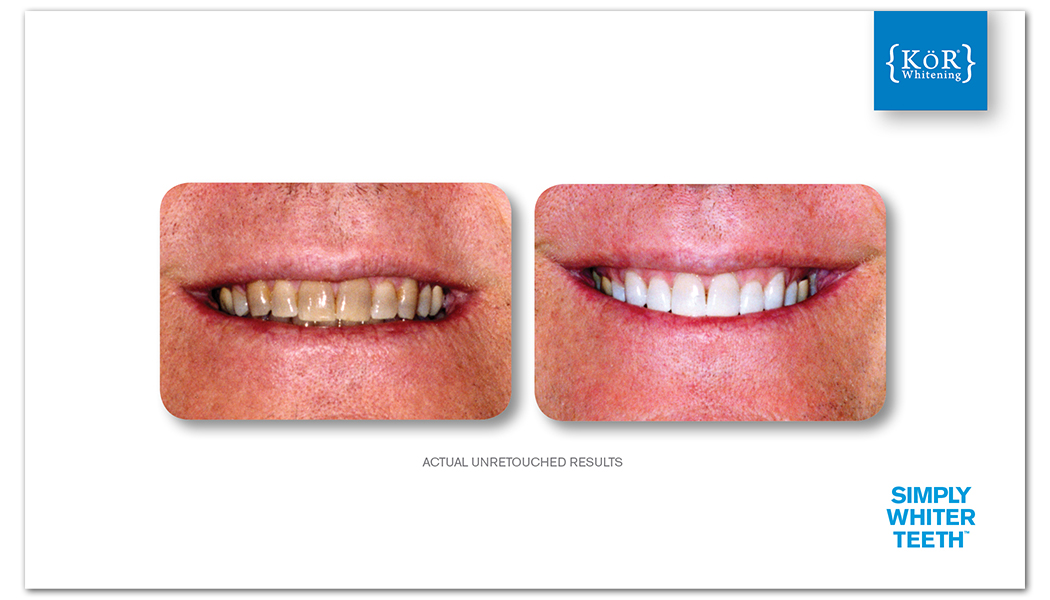In a previous post, we talked about the unique teeth whitening challenges presented when dealing with patients who have taken the antibiotic tetracycline, resulting in extremely discolored teeth, previously thought to be impossible to whiten. Prior to KöR Whitening, it was thought to be impossible to significantly whiten tetracycline staining because tetracycline color molecules can never be completely removed from the teeth’s structure.
KöR Whitening has made significant scientific strides in treating tetracycline patients and achieving amazing teeth whitening results. In this article, we will study a few different examples of tetracycline-based stains, the effects of the KöR Whitening system and recommended maintenance for each situation.
“KöR Whitening has made significant scientific strides in treating tetracycline stains and achieving astonishing teeth whitening results.”
- Tetracycline Banding in the Middle and Incisal Thirds of Teeth
Sometimes, tetracycline color banding can happen in the middle of the teeth or in the incisal third, rather than in the cervical area. Tetracycline cases with banding in the middle or incisal thirds usually produce more predictable results than cases with cervical banding.
- Major Tetracycline Banding in the Cervical
In these cases, the entire tooth, including the dark cervical band, will lighten impressively. However, the cervical band will often still be darker than the middle and incisal thirds of the teeth. In these cases, we recommend more intense Accelerated Maintenance. Occasionally, when even more uniformity is desired by the patient, targeted cosmetic bonding to mask the darker cervical band can be very effective.
- Minor Tetracycline Banding in the Cervical
In this example, we’re talking about cases that might not appear to be too difficult. Unfortunately, there is no such thing as “easy” when it comes to tetracycline staining. When there is banding in the cervical, you can often expect some remaining color gradient after whitening. The cervical area will lighten very significantly, but the rest of the tooth may whiten even more.
The typical reaction by the patient when seeing the final result is overwhelming excitement. Rarely will any remaining darker color be very noticeable. However, if even more uniformity is desired, composite bonding is very simple and very effective at masking any of the slightly darker areas. Eight full weeks of at-home whitening and Accelerated Maintenance is recommended to achieve improved lightening of the cervical areas.
- Horizontal Grooves
Tetracycline commonly affects the secretory ameloblasts. This leads to lessened, and sometimes non-existent, enamel thickness in the cervical areas. Horizontal grooves in enamel are also sometimes caused by tetracycline. When horizontal grooves are present, Accelerated Maintenance and cosmetic bonding (filling in the grooves) are recommended after KöR Whitening is completed.
- Diffuse Tetracycline Staining
We’ve found that diffuse tetracycline stains often have the best whitening results. Occasionally, the cervical areas may not whiten to the same extent as the rest of the tooth. Only in rare cases, you may consider composite bonding in the cervical if the patient wants even more consistent color appearance.
- Mild-Appearing Tetracycline Cases
No matter how mild the staining appears to be, never be fooled when it comes to tetracycline staining. The full protocol of treatment and maintenance is recommended for ideal teeth whitening results.

With the effect tetracycline has on the secretory ameloblasts and the formation of enamel, often the enamel will absorb even more bubbles of oxygen into the tooth during whitening. These millions of bubbles inside the tooth structure reflect light, artificially causing the teeth to look, WHITE after only a few days to a couple weeks. Do not let your patient be fooled. This is only an optical illusion at this point. If whitening is halted prematurely (assuming the teeth have become white already), the bubbles will exit the enamel of the teeth within several days, resulting in loss of most of the whiteness.
In all tetracycline cases, 6-8 weeks (most often 8 weeks) of at-home whitening is absolutely necessary. Accelerated Maintenance is always recommended with tetracycline stain cases, and composite bonding may occasionally be offered to the patient to mask out any residual stains. However, patients are typically so excited with the results, you will rarely find patients asking for even more uniformity (as long as you have managed the patients’ expectations properly PRIOR to treatment).
For more information about KöR Whitening and our teeth whitening systems to help tetracycline patients, contact us today.



